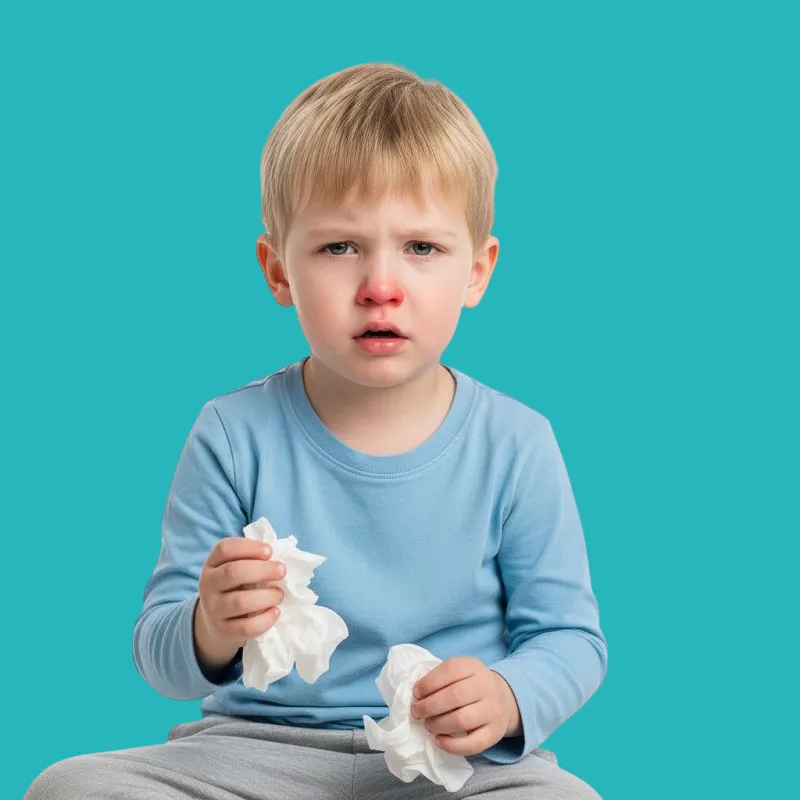Nasal congestion in children is one of the most bothersome problems that disrupts their sleep and causes difficulty breathing, especially during cold weather and winter.
Treating nasal congestion at home can help relieve congestion quickly and improve breathing without the need for strong medications in most cases.
What is nasal congestion in children?
Nasal congestion occurs due to swelling of the nasal lining or a buildup of secretions, which obstructs the easy flow of air. Causes include:
- Nasal congestion due to colds.
- Mucus buildup in the nasal passages.
- Tissue swelling due to allergies.
- Difficulty breathing, especially during sleep.
Causes of nasal congestion in children
The causes of nasal congestion in children are related to several factors that affect the airways, such as:
- Colds and viral infections.
- Seasonal or dust allergies.
- Dehydration and insufficient water intake.
- Dry air in the room due to air conditioning or heating.
Symptoms of Nasal Congestion in Children
Symptoms of nasal congestion are clearly visible in breathing patterns, including:
- Breathing through the mouth instead of the nose.
- Difficulty sleeping and light snoring.
- Runny nose or thick mucus.
- Loss of appetite and irritability.
How to Diagnose Nasal Congestion
Nasal congestion is diagnosed through simple steps followed by a doctor, as follows:
- Examining the nose to check for congestion or allergies.
- Checking breathing during sleep.
- Assessing for any accompanying infection.
- Ordering tests if the condition is chronic.
Treating Nasal Congestion in Children at Home
Treating nasal congestion in children at home can help improve breathing quickly and safely. These include:
- Using warm steam to open nasal passages.
- Using a saline solution to clean the nose.
- Elevating the child's head while sleeping.
- Offering warm liquids to reduce mucus.
Home Remedies to Relieve Nasal Congestion
There are effective and safe home remedies that can help relieve nasal congestion, such as:
- Inhaling steam from a warm shower.
- Apply warm compresses to the nose and cheeks.
- Use a humidifier in the room.
- Give warm soup to soothe congestion.
When should you see a doctor?

Some cases require a doctor's visit if nasal congestion persists, including:
- Congestion lasting more than three days.
- High fever or severe difficulty breathing.
- Excessive yellow or green nasal discharge.
- Loss of appetite or lethargy.
Complications of neglecting nasal congestion
Neglecting nasal congestion can lead to subsequent problems affecting the child's health, such as:
- Recurrent ear infections.
- Poor sleep and daytime fatigue.
- Difficulty concentrating.
- Development of sinusitis.
Tips for preventing nasal congestion
Prevention greatly helps reduce the occurrence of nasal congestion in children, including:
- Avoiding sudden exposure to cold air.
- Regularly cleaning the nose with a saline solution.
- Maintaining room humidity.
- Boosting the child's immunity with a healthy diet.
Frequently Asked Questions
Can a child's stuffy nose be treated at home without medication?
Yes, steam inhalation, saline solution, and warm liquids can be effective.
Is a child's stuffy nose normal during a cold?
Yes, it's a common symptom and usually clears up within a few days with home care.
Is saline solution safe for treating a child's stuffy nose?
It's completely safe and considered one of the best ways to clear nasal passages.
When does a child's stuffy nose become dangerous?
When it's accompanied by difficulty breathing, a persistent fever, or abnormal nasal discharge.
Article Summary
A stuffy nose in children is a common symptom that causes discomfort and difficulty breathing. Home remedies like steam inhalation, saline solution, and elevating the head can help relieve congestion quickly and safely.
However, paying attention to accompanying symptoms and monitoring the child's condition remains essential to prevent complications and maintain comfortable and healthy breathing.